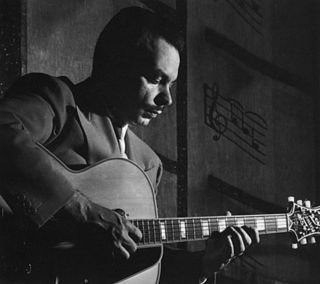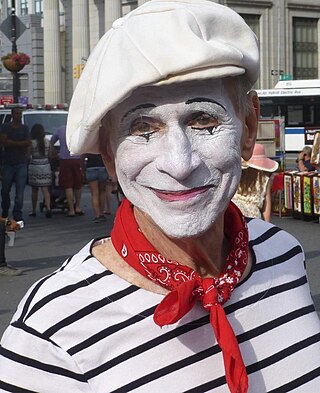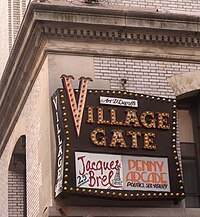
Herbert Jay Solomon, known by his stage name Herbie Mann, was an American jazz flute player and important early practitioner of world music. Early in his career, he also played tenor saxophone and clarinet, but Mann was among the first jazz musicians to specialize on the flute. His most popular single was "Hi-Jack", which was a Billboard No. 1 dance hit for three weeks in 1975.

Mitchell Herbert Ellis was an American jazz guitarist. During the 1950s, he was in a trio with pianist Oscar Peterson.

Gary Burton is an American jazz vibraphonist, composer, and educator. Burton developed a pianistic style of four-mallet technique as an alternative to the prevailing two-mallet technique. This approach caused him to be heralded as an innovator, and his sound and technique are widely imitated. He is also known for pioneering fusion jazz and popularizing the duet format in jazz, as well as being a major figure in music education from his 30 years teaching at the Berklee College of Music.

Raymundo "Ray" Barretto Pagán was an American percussionist and bandleader of Puerto Rican descent. Throughout his career as a percussionist, he played a wide variety of Latin music styles, as well as Latin jazz. His first hit, "El Watusi", was recorded by his Charanga Moderna in 1962, becoming the most successful pachanga song in the United States. In the late 1960s, Barretto became one of the leading exponents of boogaloo and what would later be known as salsa. Nonetheless, many of Barretto's recordings would remain rooted in more traditional genres such as son cubano. A master of the descarga, Barretto was a long-time member of the Fania All-Stars. His success continued into the 1970s with songs such as "Cocinando" and "Indestructible". His last album for Fania Records, Soy dichoso, was released in 1990. He then formed the New World Spirit jazz ensemble and continued to tour and record until his death in 2006.

Marc Kudisch is an American stage actor, who is best known for his musical theatre roles on Broadway.
James George Hunter, known professionally as Jimmy Rowles, was an American jazz pianist, vocalist, and composer. As a bandleader and accompanist, he explored multiple styles including swing and cool jazz.

Laurindo Almeida was a Brazilian guitarist and composer in classical, jazz, and Latin music. He and Bud Shank were pioneers in the creation of bossa nova. Almeida was the first guitarist to receive Grammy Awards for both classical and jazz performances. His discography encompasses more than a hundred recordings over five decades.
Ernest Andrew Royal was a jazz trumpeter. His older brother was clarinetist and alto saxophonist Marshal Royal, with whom he appears on the classic Ray Charles big band recording The Genius of Ray Charles (1959).

George Duvivier was an American jazz double-bassist.
Art D'Lugoff in Brooklyn, New York, was an American jazz impresario. He opened The Village Gate, a jazz club in New York City's Greenwich Village, in 1958. D'Lugoff sought out the hottest talent, hosting prominent jazz artists, including Billie Holiday, Duke Ellington, Dizzy Gillespie, Aretha Franklin, and Miles Davis, as well as the best in comedy, including Bill Cosby, Mort Sahl, Woody Allen, and John Belushi.

Chick Corea (1941–2021) was an American jazz pianist and composer born on June 12, 1941, in Chelsea, Massachusetts. Corea started learning piano at age four. He recorded his first album, Tones for Joan's Bones, in 1966. Corea performed with Blue Mitchell, Willie Bobo, Cal Tjader and Herbie Mann in the mid-1960s. In the late 1960s he performed with Stan Getz and Miles Davis. The National Endowment for the Arts states, "He ranked with Herbie Hancock and Keith Jarrett as one of the leading piano stylists to emerge after Bill Evans and McCoy Tyner, and he composed such notable jazz standards as 'Spain', 'La Fiesta', and 'Windows'."
"Yesterdays" is a 1933 song about nostalgia composed by Jerome Kern with lyrics by Otto Harbach. They wrote the song for Roberta, a musical based on the novel Gowns by Roberta by Alice Duer Miller. "Yesterdays" was overshadowed by the musical's more popular song, "Smoke Gets in Your Eyes", which was a number one hit for the Paul Whiteman orchestra.
Carlos Valdés Galán, better known as Patato, was a Cuban conga player. In 1954, he emigrated from La Habana to New York City where he continued his prolific career as a sideman for several jazz and Latin music ensembles, and occasionally as a bandleader. He contributed to the development of the tunable conga drum which revolutionized the use of the instrument in the US. His experimental descarga albums recorded for Latin Percussion are considered the counterpart to the commercial salsa boom of the 1970s. Tito Puente once called him "the greatest conguero alive today".
Samuel David Bailey was an American jazz drummer.
Raymond Mantilla was an American percussionist.
Noo Yawk Tawk was an off-Broadway show conceived and directed by Richmond Shepard which played at The Village Gate Theater from 1988 to 1991. It featured members of an improvisational comedy troupe founded by Mr. Shepard. All performances were entirely improvised. Characters may have been repeated but never the sketches or the dialogue. The audience set the conditions for each improvisation so every performance was different. The sketches were based on improvisational games which included poems, songs, a fictitious foreign movie and a scene which included the first and last line all given by audience members. The cast members used their skills of foreign accents, dialects, singing, mime and writing.

Richmond Shepard was an American writer, director, producer and mime with a 50-year history in entertainment. He was one of the oldest living working mimes in show business. He built, owned and operated his own theaters in Los Angeles on Theatre Row where he produced over 30 shows. He moved to New York and worked as a theatre and film critic for WNEW, conceived and directed the off-Broadway show Noo Yawk Tawk at The Village Gate for three years. He traveled across the world performing with mime troupes and performs improvisational comedy in various clubs around NYC. Richmond Shepard's last role was when he played the "Sandman" in Fuzz on the Lens Productions fantasy comedy Abnormal Attraction starring Malcolm McDowell, Bruce Davison, Leslie Easterbrook, and Gilbert Gottfried which was released on 26 February 2019.
"Just Friends" is a popular song that has become a jazz standard. The song was written in 1931 by John Klenner with lyrics by Sam M. Lewis. Although introduced by Red McKenzie and His Orchestra in October 1931, it first became a hit when singer Russ Columbo performed it with Leonard Joy’s Orchestra in 1932. It charted again the same year in a version by Ben Selvin and His Orchestra and has been recorded often since.

Roger Dawson is a jazz percussionist, conga drummer, bandleader, and jazz composer. He was a leading jazz and salsa disc jockey in the US and was acknowledged as being at the forefront of New York's salsa music explosion of the seventies and early eighties. He was the creator of the long-running "Salsa Meets Jazz" concert series at New York's Village Gate club.
At the Village Gate could refer to several albums recorded at The Village Gate nightclub in New York City, including:










